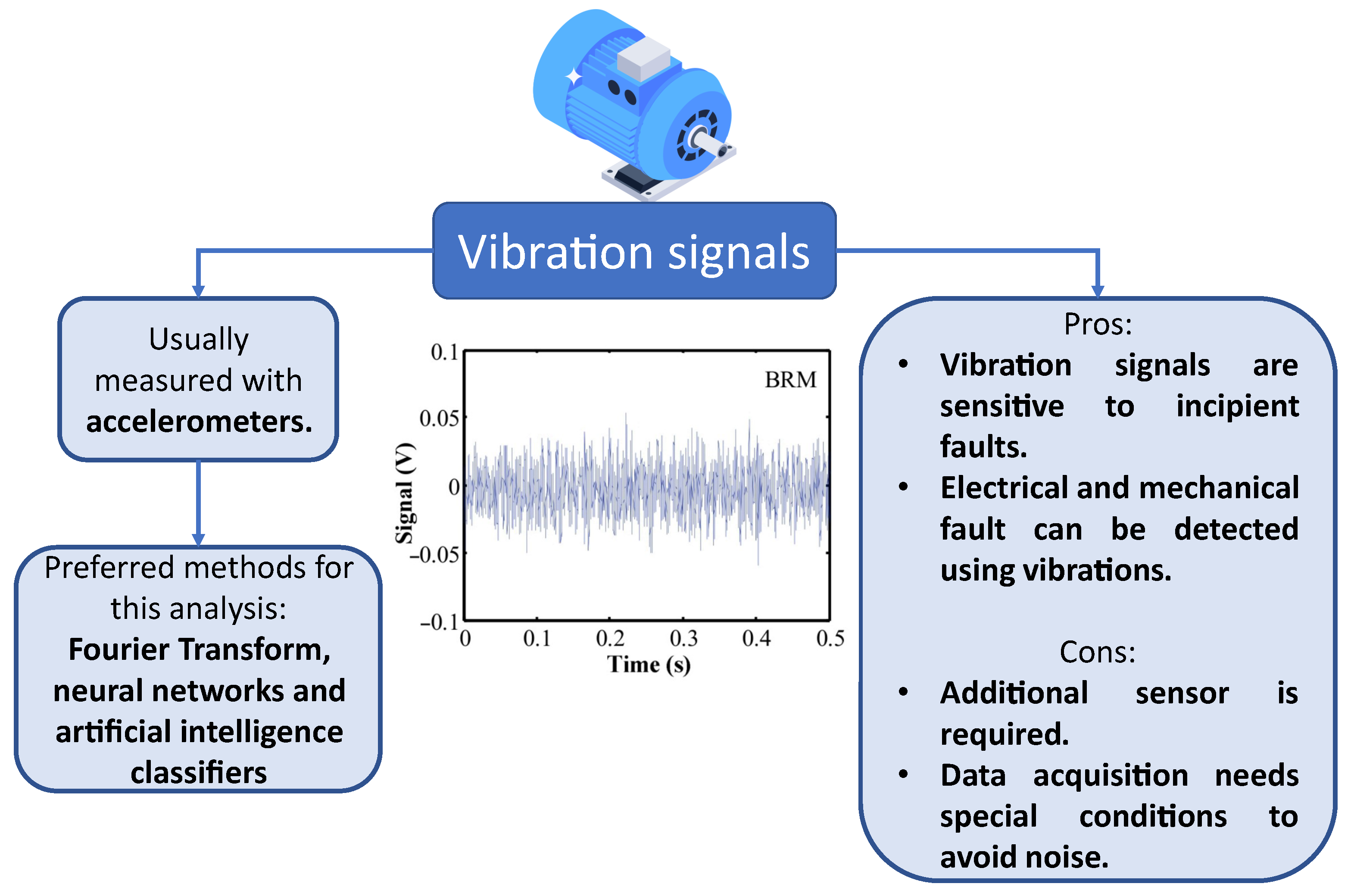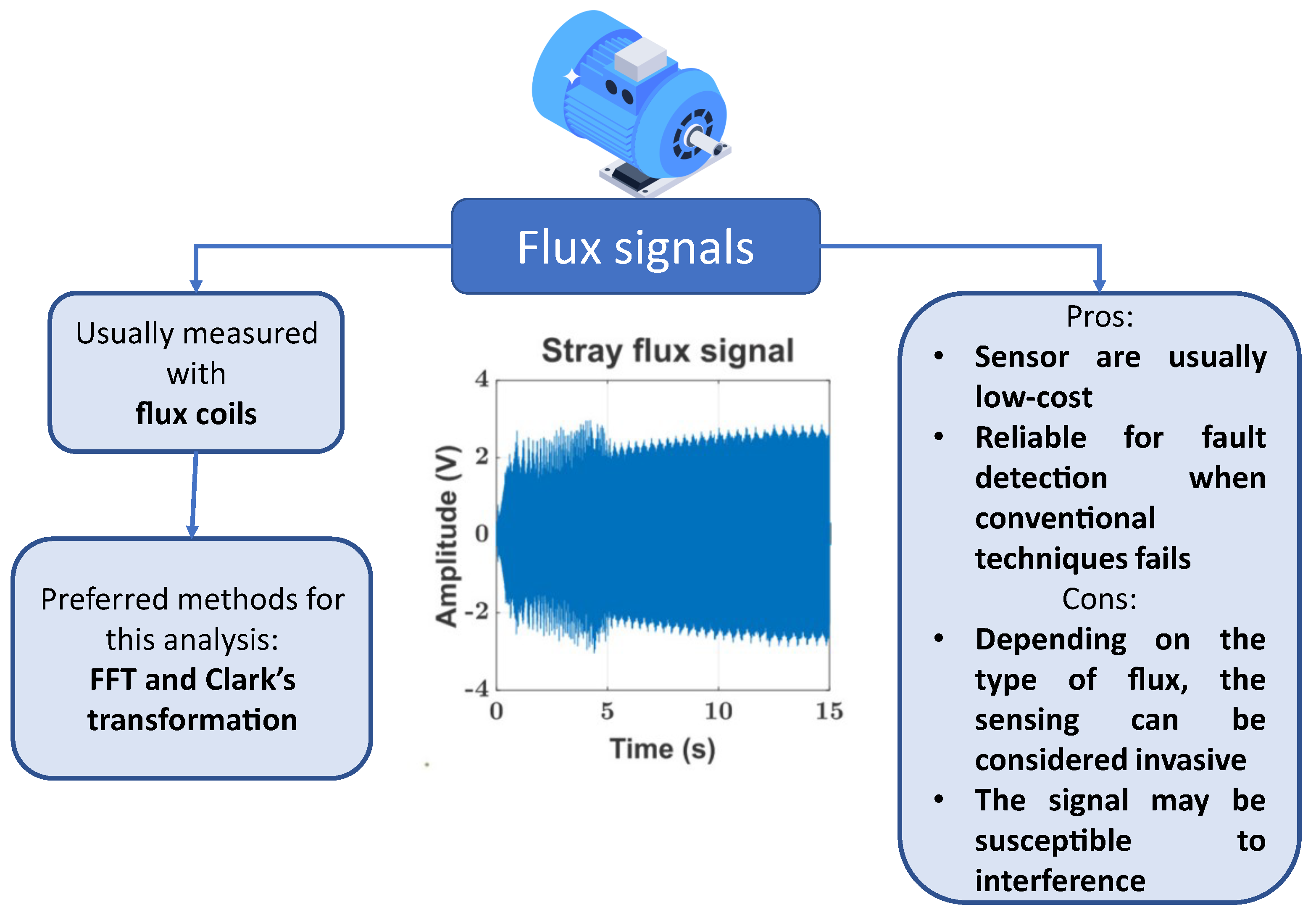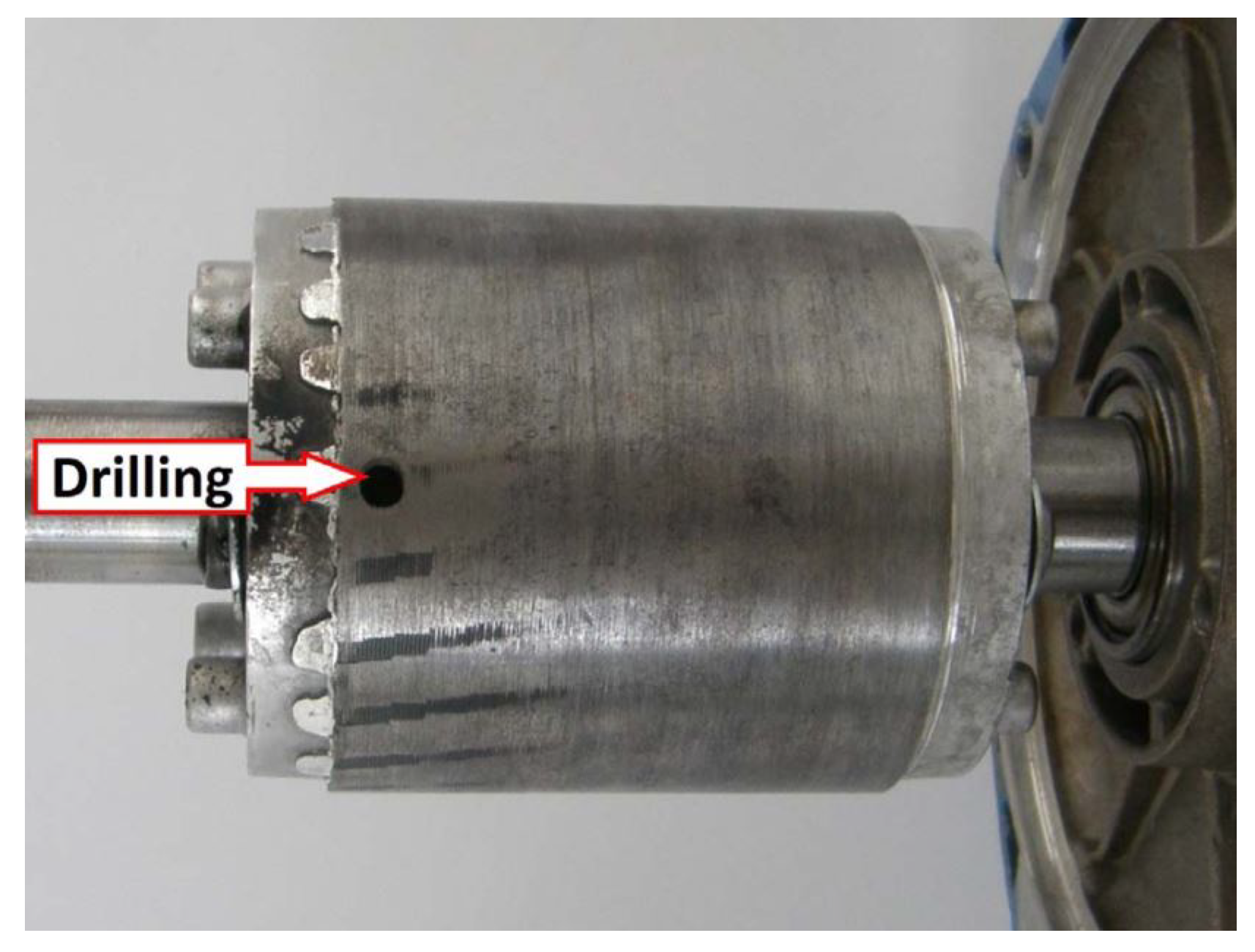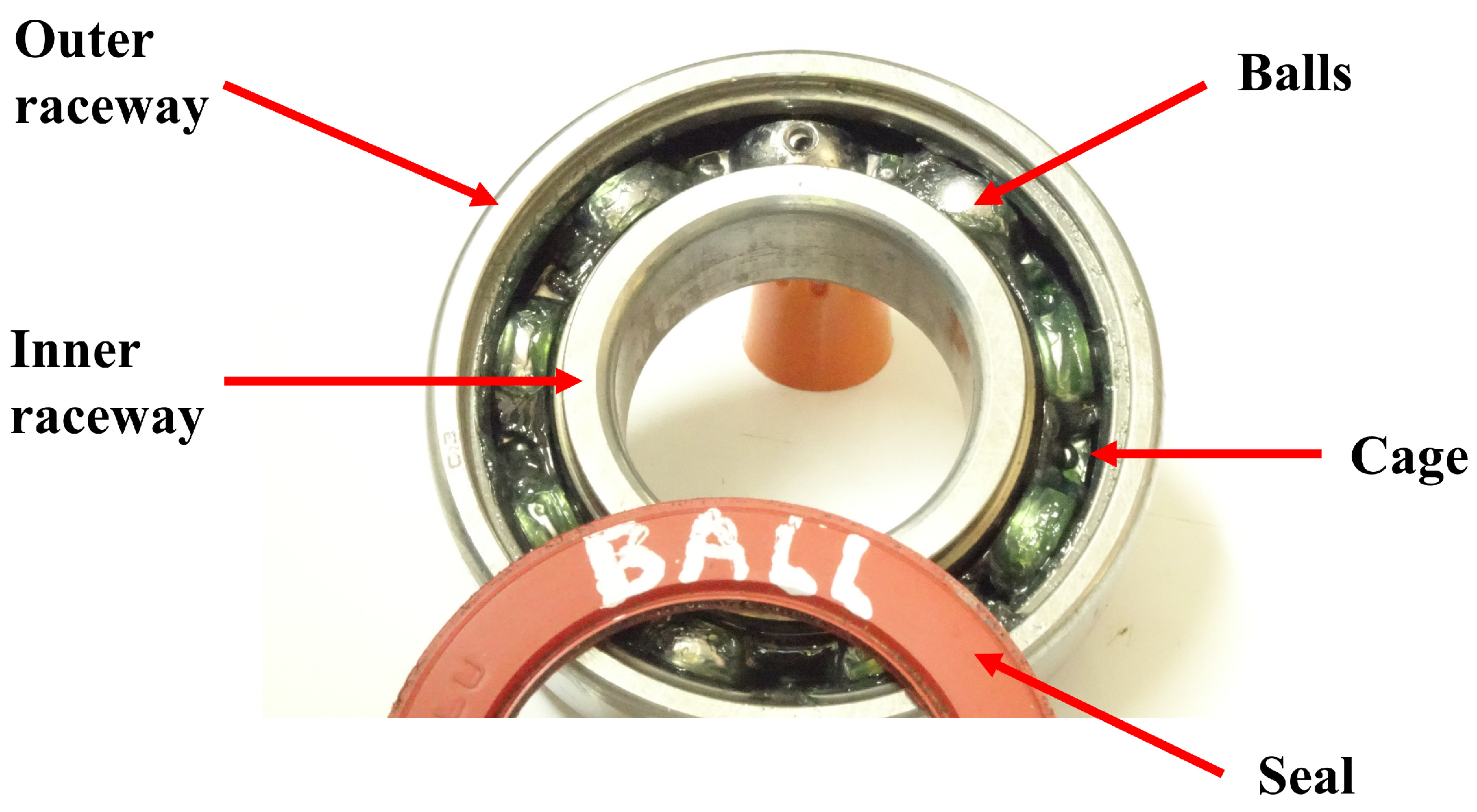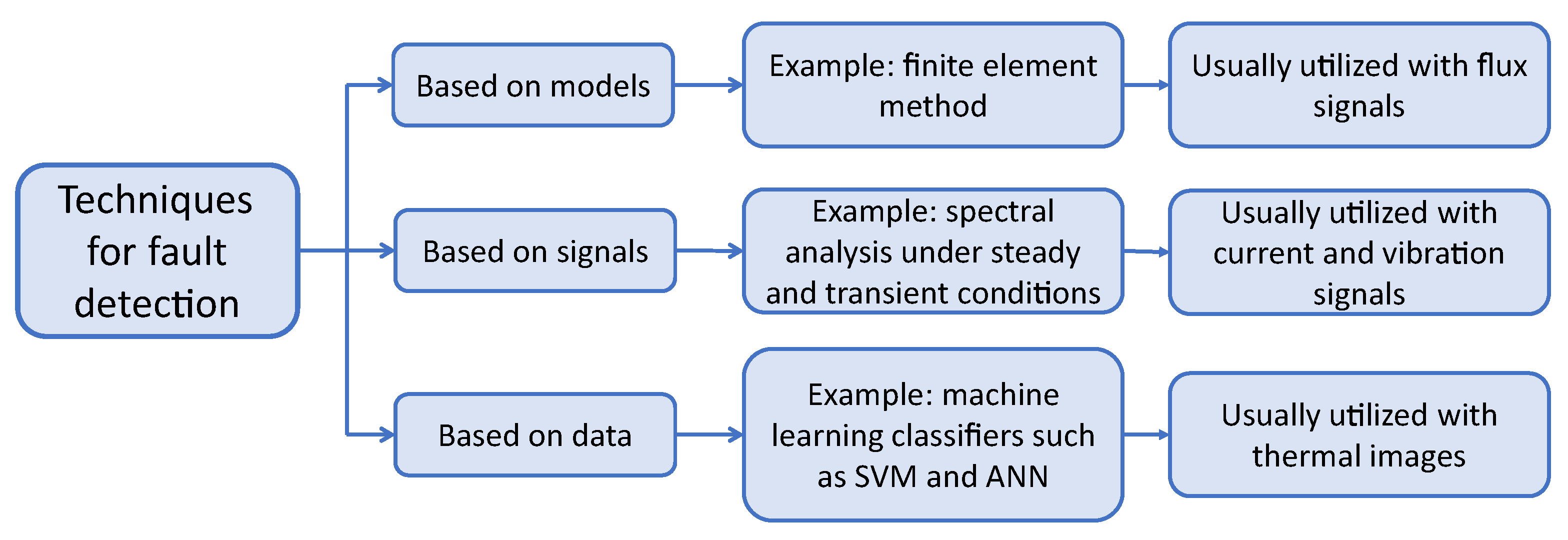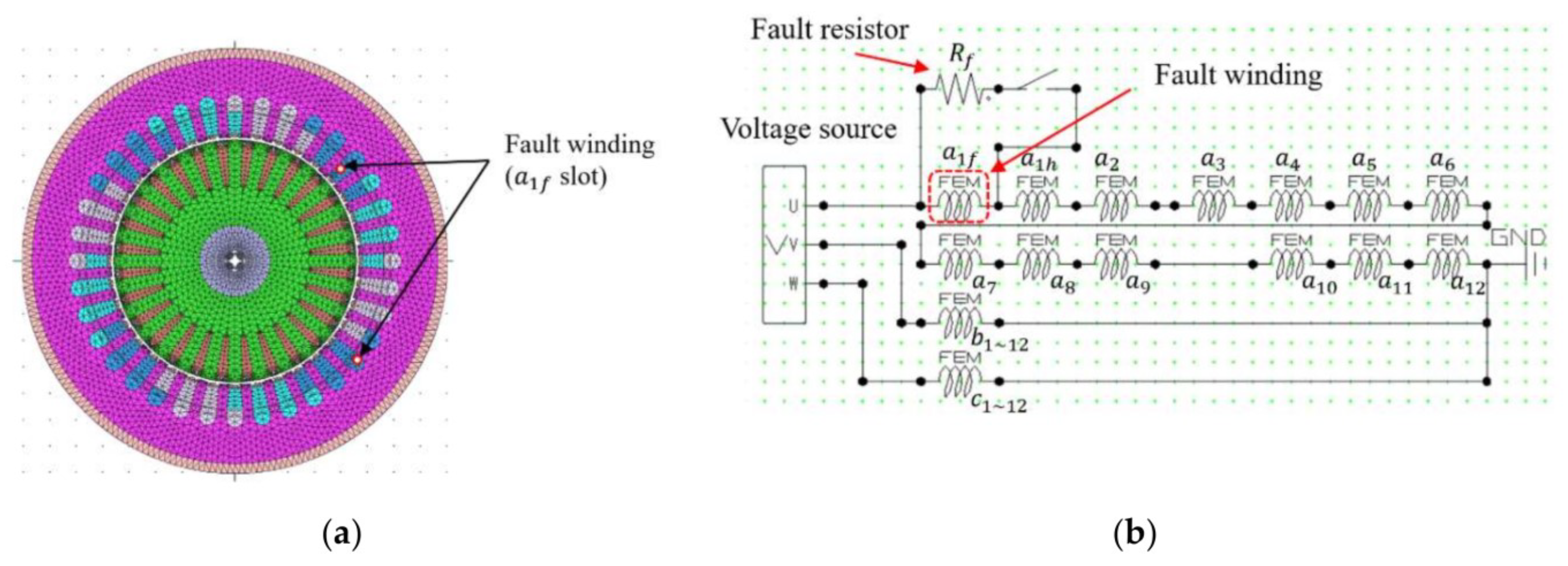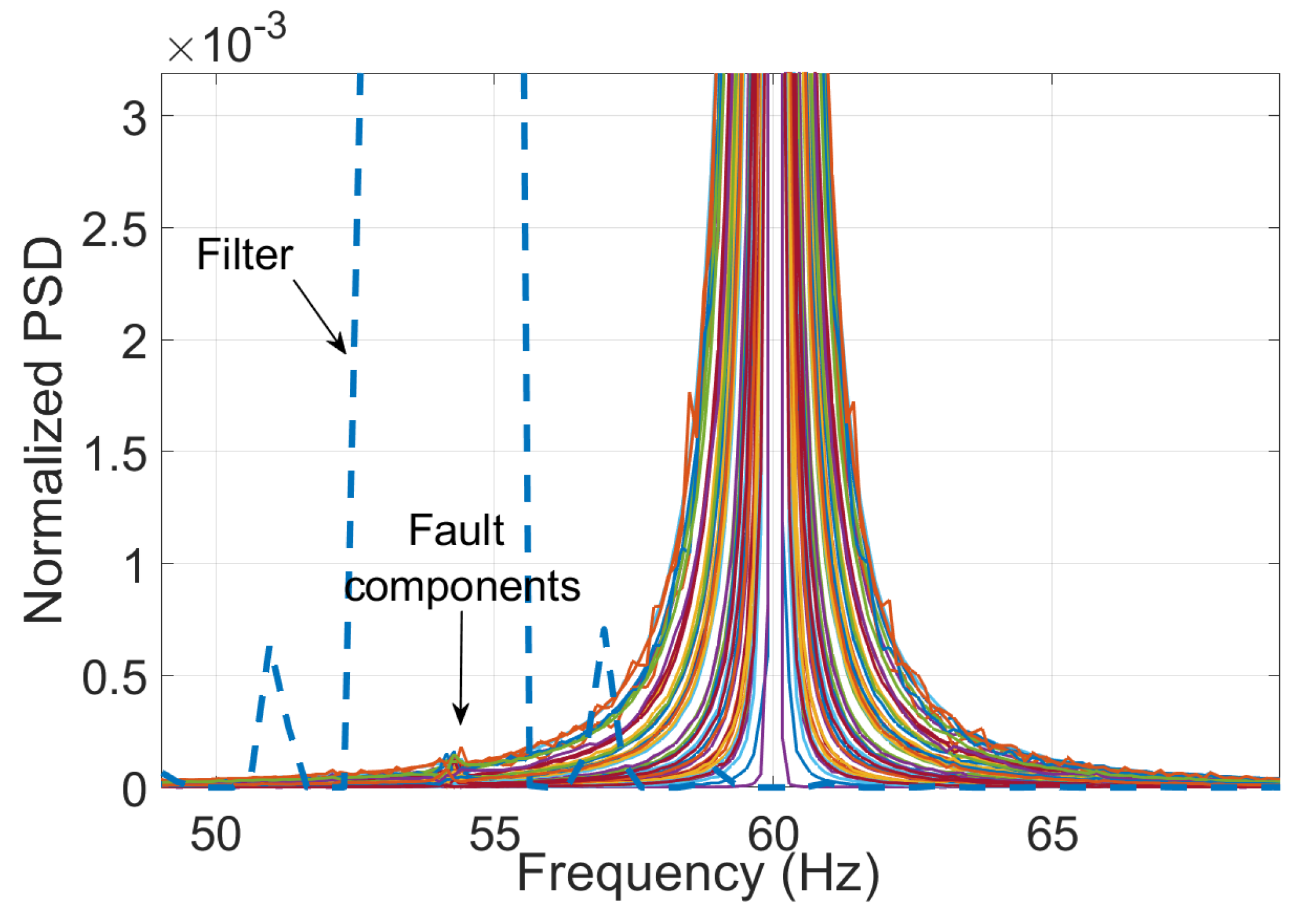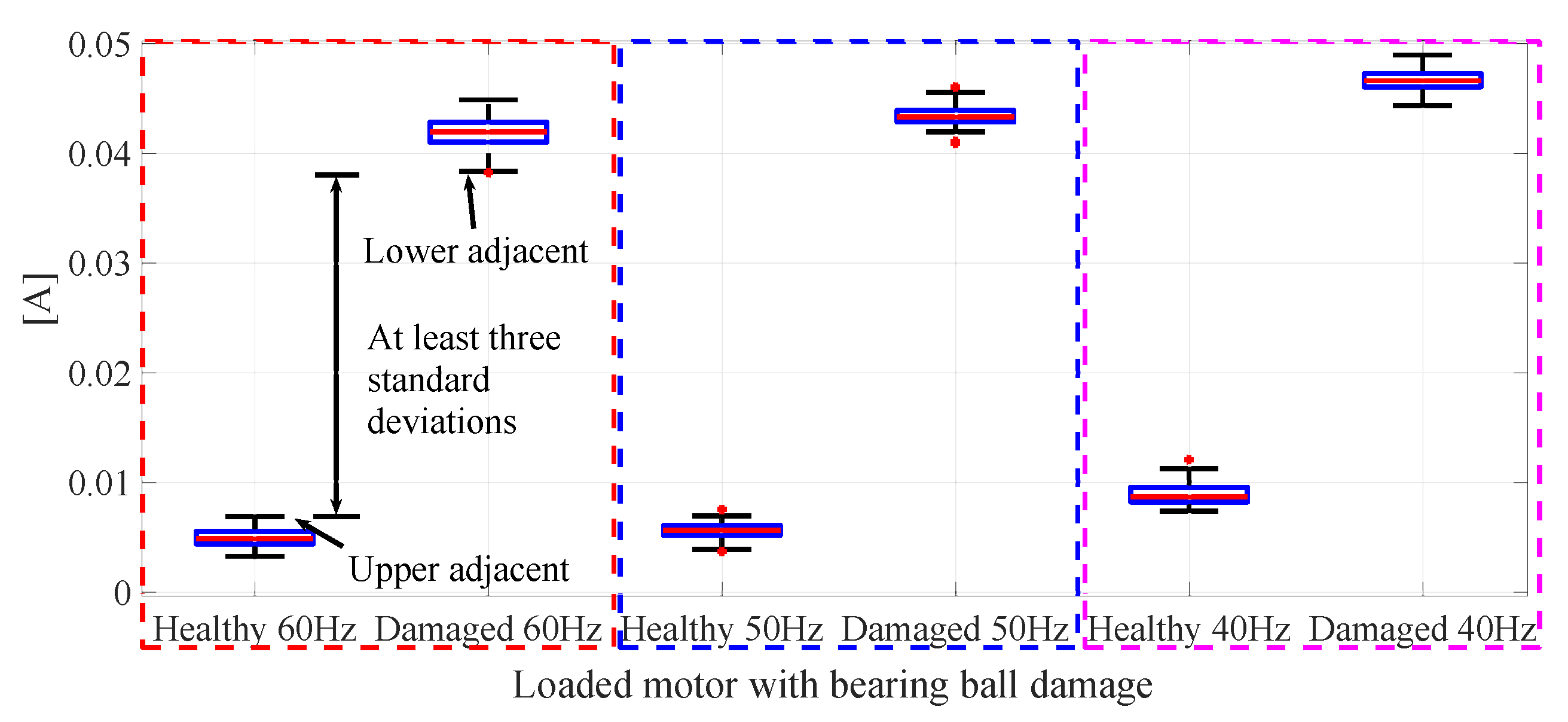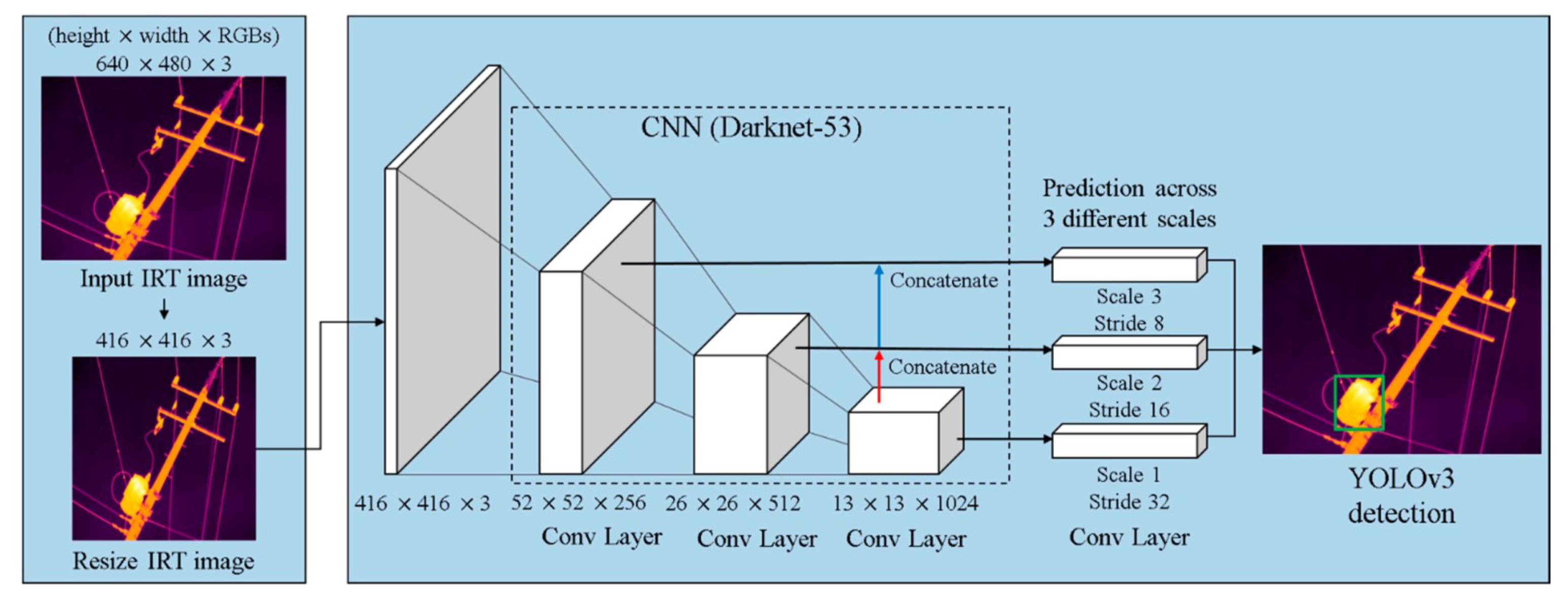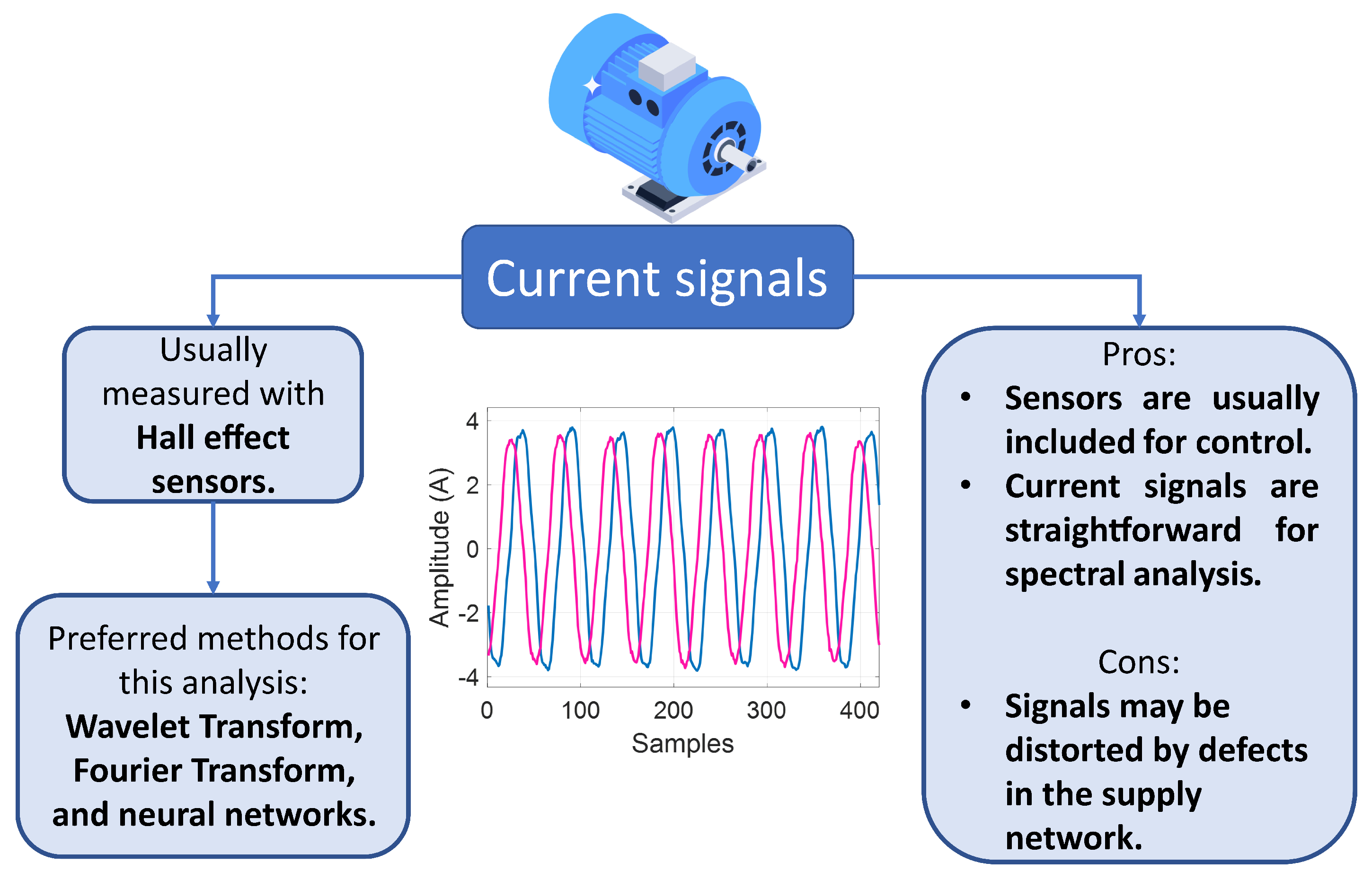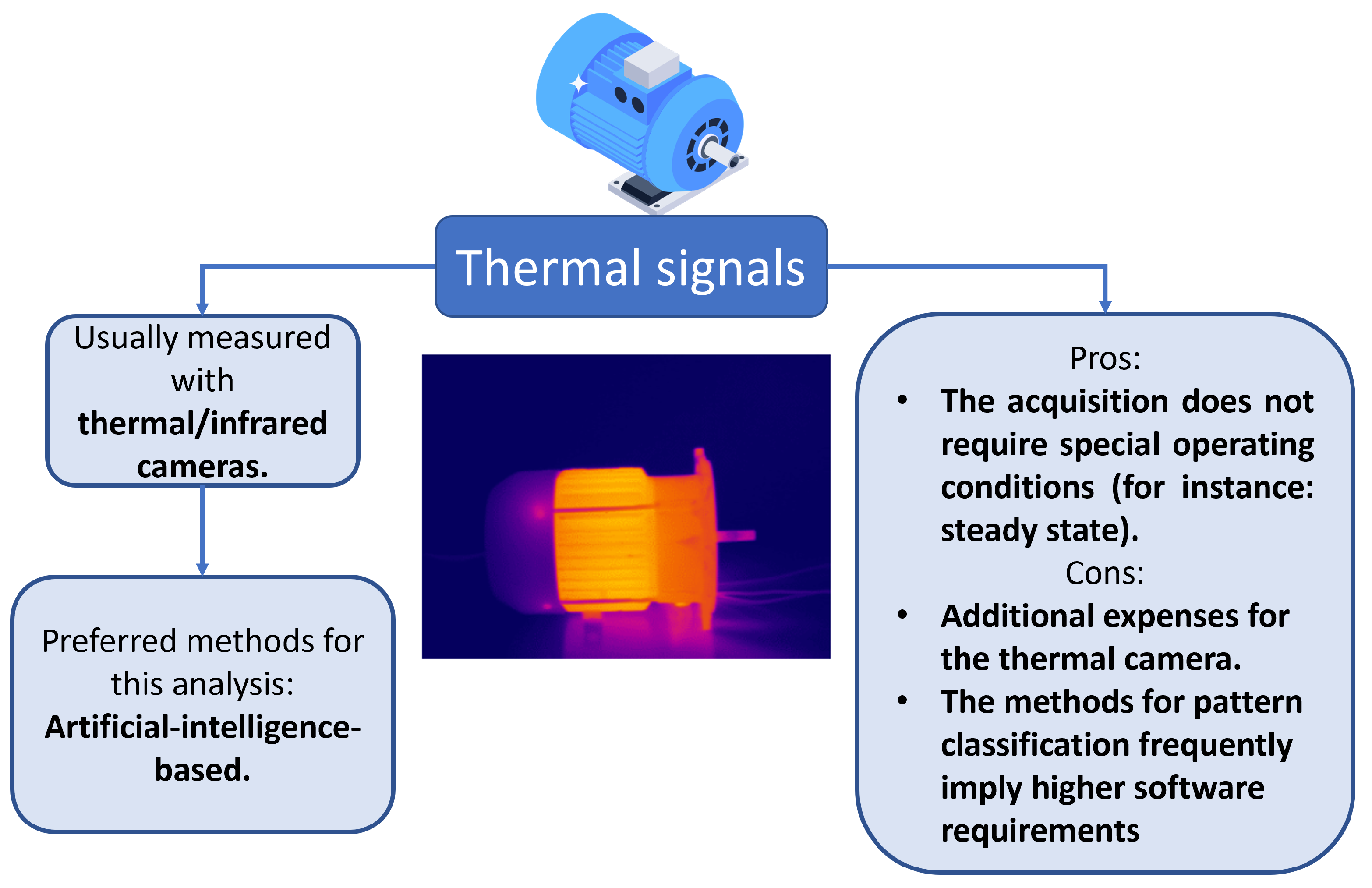1. Introduction
Induction motors (IMs) are the principal source of power in the manufacturing industry due to their sturdiness, energetic efficiency, and repair and maintenance costs.
IMs are prone to present faults associated with thermal, mechanical, and magnetic stresses or to expected causes, such as natural wear of bearings [
1]. Bearing damage is the type of fault that appears more frequently. However, other faults may appear due to unbalanced loads, unbalanced power supply, and high operational frequencies, among others. Typically, the faults with a higher frequency of appearance are: bearing faults, stator winding faults, and rotor broken bar faults [
2,
3].
Researchers have documented advances in IMs’ condition monitoring and fault detection in this context. Atta et al. [
4] summarized recent techniques for broken bar faults under starting and steady-state conditions using current, voltage, flux, vibration, and acoustic signatures. In that work, the authors subgroup the methods based on resistance estimation, parameter estimation, digital estimation, time-domain, frequency domain, time–frequency domain, and data-driven approaches. The main drawback of this work is that it is highly specialized, given that it focused only on one type of fault, in this case, broken bar fault detection. However, it provides a good panorama of the evolution of broken bar fault detection techniques in the last 8 years. The authors pointed out that some issues still require attention, such as methods for multiple-fault detection, model-based methods, transfer learning in driven-based methods, and assessing the performance of time–frequency methods under short-start duration, among others. Gundewar et al. [
5] reviewed recent techniques used for fault diagnosis in IM according to the type of fault: bearing fault (BF), rotor bar faults, air gap eccentricity, and stator faults. Moreover, they highlighted the use of artificial intelligence (AI) techniques for condition monitoring, such as support vector machines (SVMs), fuzzy logic, adaptive neuro-fuzzy inference system (ANFIS), and genetic algorithm (GA). They provided an extensive overview of different types of IM faults. Nevertheless, the techniques for fault detection are limited to AI-based, which have been proven to have high detection accuracies but at the cost of high computational resources required for its implementation. A review on IMs fault detection based on current analysis was presented by Yakhni et al. [
6], focusing on applications with variable speeds. The authors summarized the methods based on current analysis for detecting particular faults: broken rotor bar, bearing, eccentricity, stator fault, inter-turn short circuit, and unbalanced supply. This paper contributes to reviews of current-based analysis. However, it only focuses on two approaches: the adaptive observer and the adaptive notch filtering method.
This paper presents a revision of the recent works and tendencies in the types of physical variables employed for fault detection. Although previous works have discussed advances in fault detection and condition monitoring, these are mainly centered on the type of fault or the methods themselves, not so in detail regarding the type of physical variable.
2. Common Types of Faults in Induction Motors
Different types of physical variables are measured and analyzed to detect the presence of a fault in IM. Induction motors are prone to present faults associated with electrical, mechanical, or environmental aspects. Electrical faults can be induced, among others, by supply current unbalance and overload, and faults such as short circuits are produced. Mechanical faults, however, are related to broken bars and bearing damage. Certain environmental conditions, such as humidity and very high or low temperatures, may affect the IM and progress into electrical or mechanical faults. Some of the faults that appear in IMs more commonly are presented next.
Damage in the rotor bars is difficult to detect since the induced spectral components lie near the supply frequency. Moreover, as the severity of the fault increases, the spectral components are greater in amplitude. As the load of the motor increases, the fault components are further from the fundamental frequency. Hence, incipient faults, commonly less than half broken bars, are more difficult to detect; the load condition also affects the fault detection accuracy.
The fault is created synthetically by drilling the bar to study broken rotor bars, as illustrated in
Figure 1. Most works that study the presence of broken bars in IMs analyze 1 and 2 BRB; few works are able to detect less than 1 BRB, given that it usually requires complex algorithms for signal processing.
Broken rotor bars are commonly detected by means of motor current signature analysis, where the current spectrum is processed and analyzed, searching for changes in the amplitude of certain frequency spikes. These components usually appear near the fundamental frequency, as the following equations indicate this:
where
are the spurious frequencies,
p represents the number of pairs of poles,
s is the slip,
represents the frequency of the grid, and
h is an index that represents the number of harmonics.
In a similar way, the localization of spurious frequencies can be performed by using vibration analysis, following the next equation:
where
represents the spurious frequency,
k represents an integer index,
is the frequency of the grid, and
s represents the slip.
It is well known that bearings in an IM are fundamental elements since this allows the rotor to rotate on its own axis. Due to its mechanical nature, bearings are under mechanical and electrical stresses. A common IM bearing is conformed by static and mobile elements, as shown in
Figure 2.
The seals maintain the lubricant inside the bearing and keep the contaminants out; the mechanic load is transferred from a foothold to a rolling point, i.e., from the inner raceway to the outer raceway through the rolling elements (balls or rollers), and the cage maintains the rolling elements in its position.
Bearing faults are mostly identified using vibration signals [
7,
8]. Spurious frequencies based on vibration analysis can be localized according to the next equations [
9]:
where
,
, and
represent the spurious frequencies for outer race damage, inner race damage, and bearing ball damage, respectively;
represents the number of balls;
represents the angle between the ball and the defect;
is the diameter of the ball; and
is the pass diameter.
In this way, previous works have studied bearing faults through vibration analysis, expecting the appearance of the fault’s frequencies, as stated by the aforementioned equations.
The most recurrent faults related to a shortcut are the stator winding and rotor shortcuts. A short circuit is one of the most difficult faults to detect; protection systems commonly detect the shortcut when damage is critical. A grounded shortcut results in severe damage to the machine’s integrity.
There are several approaches used for shortcut detection. The most used are as follows:
Analysis of the magnetomotive forces;
Winding function approach;
Dynamic mesh reluctance approach;
Finite element.
If a stator fault exists, the current through the shorted winding will cause variations in the normal magnetic field and variations in the axial flux according to the next equation [
10]:
where
is the grid frequency,
n is the order of the shorted coil space harmonic,
k is the harmonic order,
s represents the slip of the machine, and
is the number of pole pairs.
2.1. Effects of Vibrations in Induction Machines
Faults in induction machines may cause negative effects in the normal operation of the motor regardless of the cause; some of the principal vibration sources are voltage/current imbalances, rotor bar defects, bearing defects, voltage distortion of the power grid, and speed driver issues, among others. There are two main sources of vibrations: mechanical and electromagnetic origin.
Vibrations of mechanical origin are mainly caused by rotor imbalance, shaft bow, and misalignment or wear in mechanical elements.
Electromagnetic vibrations provoke for radial electromagnetic forces and tangential electromagnetic forces. Under normal operation conditions, these forces do not represent significant vibrations. Excessive electromagnetic motor vibrations are often a result of a resonance condition on the structure of the motor as a unit or even on the motor components [
11]. Vibrations may cause or accentuate problems, such as misalignment and eccentricity, among others. These problems are discussed next.
2.2. Misalignment
Misalignment can be caused by the deviation of the coupling axis between the load and motor shafts. Excessive vibrations will provoke asymmetries in the motor frame, shaft, and bearings in the IM. If the misalignment fault is not detected early, the consequences could be bearing damages, eccentricity, and gearbox failures.
The two types of misalignment issues in IMs are parallel and angular faults. A parallel fault occurs when there is a height difference between the shaft centers of the load and the IM, and an angular fault occurs when an inclination exists between the load and the IM. The combination of parallel and angular misalignment is called mixed misalignment. The coupling differences between the shafts emerge in the frequency spectrum of current as follows [
12]:
where
represents the spurious frequency of the misalignment signal frequency,
k is an integer operator,
p represents the number of pole pairs,
is the supply frequency, and
s is the slip of the motor. Similarly, the spurious frequency can be obtained for the vibration spectrum as follows,
where
is the rotational frequency.
2.3. Eccentricity Air Gap
Eccentricity can be classified as dynamic and static. Dynamic eccentricity occurs when the center of the rotor is not at the center of rotation, and the position of the minimum radial air gap rotates with the rotor. Static eccentricity occurs when the position of the minimum radial air gap is fixed. Both static and dynamic eccentricity produce a polar pair,
, in the spatial distribution of the magnetic field in the air gap, where
p represents the number of the fundamental polar pair [
13,
14].
An eccentricity fault provokes spurious components in the current spectrum according to the following equation:
where
represents the eccentricity order equal to 0 for statistic eccentricity and integer coefficient
for dynamic eccentricity;
f is the frequency of the power supply;
s represents the slip;
p is the number of poles;
R represents the number of rotor bars;
k is a positive integer coefficient; and, finally,
v represents the harmonic order of the stator supply voltage [
15].
In the next section, fault detection techniques are discussed.
3. Analysis of Faults Based on Physical Variables
According to the features of the fault detection techniques, these can be classified into model-based, signal-based, and data-based techniques, as illustrated in
Figure 3. Depending on the type of physical variable, some of these methods are more adequate than others for fault detection.
For instance, a method based on models is proposed using flux signals, where a finite element method (FEM) simulation is implemented, as illustrated in
Figure 4. These methods usually imply converting the flux signals into the DQ frame.
On the other hand, an example of a technique based on signals may comprehend selective filtering of current or vibration signals and statistical analysis, such as the works in [
17,
18]. The filtering of the signal that is illustrated in
Figure 5 depicts a narrow bandwidth Taylor–Fourier filter over a current signal, and
Figure 6 illustrates the decision making according to the three standard deviation criteria for fault detection based on statistical distributions of the amplitude of the filtered signals.
An example of a method based on data is presented in
Figure 7, where an architecture based on a convolutional neural network is applied to detect electrical faults by using thermal images. Thermal images are commonly processed, as presented in [
19], with AI methods.
Next, details regarding detecting faults based on certain types of signals are given.
4. Methodologies for IMs Diagnostic
Fault detection and classification methodologies depend mainly on the implemented algorithm. The elements to traduce the physical variables to processable information are known as sensors. Sensors are indispensable for measuring physical variables and looking for valuable information for detection and classification. The most used sensors are current and voltage sensors, accelerometers, encoders, thermographic cameras, acoustic sensors, and antennae, among others [
20].
Inherent to the sensor’s use, data acquisition systems must store the physical variables to be processed. Those systems can be digital or analog; commonly, aiming to avoid complications, data acquisition boards are used. Other possibilities include embedded systems such as microcontrollers or field programmable gate arrays (FPGAs). Commonly, the sampling frequencies can be fixed from a range going from 1 (Khz) to 100 (Mhz), and the data acquisition systems can include filters to avoid aliasing or noise.
A variable analysis is commonly performed in the frequency domain. One of the most used techniques for signal processing is Fourier transform, and recently, techniques based on AI for characterization and classification have been developed. Regardless of the physical variable that is analyzed, machine learning methods have stood out as one of the best options for fault classification and pattern recognition, at the cost of being the most complex algorithms and requiring high computational resources for its implementation. Some of these methods are mentioned next:
Convolutional neural network (CNN): This is a neural network conformed by multiple filtering and classification stages, where the filtering layer extracts the features from the inputs (current, vibration, or another signal), and the classification stage is a multi-layer perceptron that deals with the classification of the faults [
21]. The advantage of using CNN is that it can provide good results with raw data; in other words, usually, no pre-processing is required, and previous feature extraction is unnecessary.
Support vector machine (SVM) and k-nearest neighbor (KNN): SVM establishes a decision boundary in a way that the location between classes is as far as possible; it is fundamentally a binary classification where a hyperplane separates the classes. On the other hand, KNN requires calculating a Euclidean distance between samples to determine similarities between these samples. Then, according to the similarities, a sample is classified into a certain class. KNN is one of the simplest machine learning methods for classification problems. These methods have been implemented using both current and vibration signals [
22,
23,
24].
Deep learning: This is a type of machine learning based on artificial neural networks with multiple layers. These neural networks attempt to simulate how the human brain works. Recently, several techniques based on deep learning have been proposed. Among the most interesting methodologies are those that are based on the recognition of thermal images because those methods do not disturb the normal operation of the system; these kinds of techniques are based on the analysis of the thermal behavior of the faulty region in an induction machine [
25].
In the next sections, physical variables and their analysis techniques are listed.
4.1. Current
Motor current signal analysis (MCSA) refers to the process used to obtain information about the dynamic of the electric machine by signal processing from the stator currents. The current signals in the time domain are usually obtained through current sensors with resistive shunts at their outputs [
26]. Frequently, researchers obtain the current samples from different speeds, frequencies, and load conditions to acquire behavioral information on the dynamics under different conditions to apply the detection and classification techniques in practical scenarios, such as industrial applications.
Motor faults affect the spectrum of the stator current signals; several techniques for fault detection in induction motors based on MCSA have been proposed for detecting both electrical and mechanical issues, and commonly, these techniques are based on algorithms for spectrum analysis to find fault signatures, aiming to detect and classify the location and severity of the fault [
27,
28,
29,
30,
31,
32,
33,
34,
35,
36,
37].
Current-based analysis for fault detection usually involves using a Hall-effect sensor concerning the signal acquisition; these are commonly included in the instrumentation installed in the IMs for control and protection purposes. Therefore, no additional expenses are required, nor is invasive sensing needed. Current signals are studied for fault detection, mostly in the frequency domain, to identify components introduced by the fault, such as broken rotor bars (BRBs) and inter-turn short circuits (ITSCs).
In 2016, Romero et al. [
38] proposed a method to detect 1 BRB and eccentricity produced by a motor-load misalignment relying on complete ensemble empirical mode decomposition (CEEMD) and multiple signal classification (MUSIC). In that work, a time–frequency analysis is conducted to identify the faults under the start-up and steady-state regimes of the motor. The authors presented an experimental setup where the current signals were acquired with a Honeywell CSNE151 Hall-effect current sensor. Then, the proposed methodology was compared with others such as STFT, Wavelet and STFT, EMD and STFT, MUSIC, and Wigner–Ville. The results highlighted that CEEMD and MUSIC exhibited better detectability than the other methods under both start-up and steady-state conditions.
In 2021, Yang et al. [
37] explored the combination of modified ensemble empirical mode decomposition (MEEMD) energy entropy and ANN to analyze stator current signals. In that work, current signals were decomposed with MEEMD, and a cross-correlation criterion selected the components with more information. Then, the energy entropy of these signals was calculated and stored in a vector. Finally, the vectors fed the ANN to identify BRB and air-gap eccentricity. The work reported a detection accuracy of 99% and an improvement respecting EEMD with ANN and MEEMD with SVM. The authors used simulated data, which can be considered a drawback given that data collected from an experiment usually includes some of the effects that are more likely to be present in the industry.
Various processing methods combined with AI classifiers have been reported in the last few years for fault detection of different types. For instance, in [
39], faulty bearings, different levels of short circuits in the stator coils, and different levels of BRB are detected using a multi-agent system based on AI. In other work, for detecting winding insulation burn, bearing damage, and BRB, the authors in [
40] proposed using spiking neural networks to analyze the current signals of the IM.
Hence, it is noticeable that the current analysis is very popular for condition monitoring and fault detection in IMs.
Table 1 summarizes different works based on current analysis. Each work is divided by year, the type of sensor employed for the signal acquisition, the type of fault that is detected, and the method for the analysis.
Table 1.
Works based on current analysis.
Table 1.
Works based on current analysis.
| Year | Type of Sensor | Type of Fault | Method |
|---|
| 2017 [41] | Current clamp model i200s from Fluke | Half BRB, 1 BRB, and 2 BRBs | Homogeneity |
| 2017 [42] | Digital signal processor board dSpace 1104 | 1 BRB for different loads | Sliding window discrete Fourier transform |
| 2017 [43] | LA-55P current sensor | 6 types of stator faults, 3 types of rotor faults, 3 types of unbalance voltages, and outer raceways bearing fault | Fast Fourier transform (FFT) and multiple Park’s vector (MPV) approaches |
| 2018 [44] | Software | 1 BRB for full load and half load | MUSIC, least-squares magnitude estimation, niche bare-bones particle swarm optimization, and singular value decomposition (SVD) |
| 2019 [45] | Data acquisition system | Bearing axis deviation, stator, and rotor friction; rotor end ring break; and poor insulation | Recurrence plots and convolutional neural networks (CNNs) |
| 2021 [46] | Current sensor | 1 BRB, 2 BRBs, and 4 levels of ITSC | Discrete wavelet transform (DWT), ANFIS, and Clark’s transformation |
| 2021 [47] | Software | Stator winding faults: phase to phase and phase to ground | FFT, Short-Time Fourier Transform (STFT), Continuous Wavelet Transform (CWT) and Long Short-Term Memory (LSTM) |
| 2021 [48] | Software | 1-1 broken diametrically opposite rotor bars | Finite element method and multilayer perceptron |
| 2021 [49] | Current sensor | 1 BRB, 2 BRBs, and bearing damage | Principal component analysis (PCA), radial basis function neural networks, and probabilistic neural networks |
| 2021 [50] | Current sensor | 2 BRBs | MUSIC |
| 2022 [51] | NI 9246 module and cDAQ-9178 | Rotor misalignment, BRB, and ITSC | FFT, power spectral density (PSD), and autocorrelation function |
| 2022 [52] | Hall-effect current sensor | BRB and ITSC | FFT and motor current normalized residual harmonic analysis |
| 2022 [53] | Signal extractor NI PX1-1033 | Broken bearings, BRB and ITSC | Symmetrical uncertainty, genetic algorithm, Hilbert–Huang transform, and SVM |
In
Figure 8, aspects related to the analysis of current signals are summarized: the preferred instrument for acquisition, method for analysis, and pros and cons of using this physical variable.
4.2. Vibrations
IMs inevitably produce vibrations during operation because of their rotatory nature. Vibrations may cause imbalance and misalignment in the electromechanical system, and those issues are accentuated when a defect exists in the motor. Vibrations directly affect the air-gap eccentricity, which influences the uniformity of the distance between the rotor and the stator, indirectly affecting the stator currents.
Fault signature depends mainly on the geometry of the damaged element. The principal disadvantage of vibration analysis on an IM is system isolation since vibrations of the surrounding elements introduce noise to the measurements. Devices such as accelerometers are commonly used to sense the induction machine’s three-axis movements with respect to time [
54].
Vibration analysis has been widely studied for fault detection, mainly because most of the faults that can appear in an IM will have an effect on the vibration measurements [
55,
56]. In 2016, Sun et al. [
57] employed a deep neural network (DNN) to classify BRB, bowed rotor, inner race bearing fault, ITSC, and unbalance rotor. This approach utilized a sparse auto-encoder based on the measured vibration data for feature learning. Moreover, the authors compared the DNN performance with a neural network, SVM, and linear regression; for the five types of faults, DNN presented the best accuracy results.
In 2019, Lee et al. [
58] measured vibration data from an IM with rotor fault and bearing fault and used a CNN for fault classification. Vibration data were measured by means of a vibration sensor and NI-9231. Classification accuracies of 98–100% were reported in this work, highlighting that the vibrations signals did not require a frequency domain transformation, as is commonly required for a current-based analysis.
Other recent works have frequently proposed methods, including neural networks such as CNN and deep convolutional neural networks (DCNNs), for bearing fault classification [
59,
60,
61]. Some of the pros and cons of vibration-based analysis are summarized in
Figure 9.
Recent works on fault detection based on vibration analysis are listed in
Table 2.
Table 2.
Works based on vibrations analysis.
Table 2.
Works based on vibrations analysis.
| Year | Type of Sensor | Type of Fault | Method |
|---|
| 2016 [62] | Software | Unbalance and misalignment motor faults | Orbital analysis, Steinbuch Lernmatrix for classification and binarization process |
| 2017 [63] | Accelerometer of an Android mobile phone | 2 BRBs and inner raceway bearing fault | FFT and motor speed estimation |
| 2017 [23] | Accelerometer 604B31 | 3 turns shorted stator winding, unbalance rotor, inner race bearing fault defect, 3 BRBs and bowed rotor | Back-propagation neural network and SVM |
| 2019 [58] | Vibration sensor and NI-9234 | 1 BRB and bearing fault | CNN |
| 2019 [64] | Spectrum analyzer | Rotor bending, inner ring bearing fault and BRB | FFT and cerebellar model articulation controller |
| 2021 [61] | Single antenna’s nearfield effect | Inner and outer race bearing damage, unbalance | DCNN and FFT |
| 2021 [65] | Accelerometer | BRB, rotor deflection, bearing fault, stator winding fault and rotor unbalance | Transfer PCA |
| 2021 [60] | Accelerometer | Short circuit of 2, 4, and 8 turns; air-gap eccentricity; BRB, broken bearing cage; bearing abrasion fault; bearing ball fault; and inner and outer race bearing damage | Nearest centroid classifier and CNN |
| 2022 [66] | IMI 608A11 accelerometer | Outer and inner race bearing damage | Electromagnetic dynamic coupled modeling method |
| 2022 [67] | Piezoelectric accelerometer sensor and PCI-1711 | BRB and cavitation fault | Ensemble framework, fuzzy rough active learning, and drift detection |
| 2022 [24] | Software | 1 BRB, 2 BRBs, 3 BRBs, and 4 BRBs | Random forest, decision tree, k-nearest neighbor (KNN), STFT, and CNN |
| 2022 [68] | Accelerometer | 1 BRB, 2 BRBs, and outer race of rolling bearing fault | Cyclic modulation spectrum, fast spectral correlation, Teager–Kaiser energy operator, and STFT |
Figure 9.
Highlights of the vibration-based analysis. Vibration signal taken from [
65].
Figure 9.
Highlights of the vibration-based analysis. Vibration signal taken from [
65].
4.3. Temperature
Thermal analysis is a process based on a nonintrusive and noncontact technique for monitoring systems. In recent years, this kind of analysis has grown in popularity due to the large amount of information provided by thermal images. For instance, when a bearing fault occurs, the friction operation coefficient upon operation increases, which leads to an increase in the temperature of the IM [
69].
This kind of analysis is commonly implemented based on complicated computational processes due to image processing. Fault detection based on thermal images requires the use of special cameras; this type of instrument is more unusual than, for example, a current clamp.
Despite the complications of thermal analysis, some works have been committed to proposing new methods for fault detection, such as the one presented by Mahami et al. [
70] in 2021, where an infrared thermography technique was applied to detect eight different short circuit faults in the stator winding; a bag-of-visual-words model was used for feature extraction, and the fault patterns were identified using an extremely randomized tree. In that work, the classifier is compared with KNN, SVM, least-squares SVM, random forest, deep-rule-based, and self-organizing fuzzy logic classifier approaches, and the results prove that the extremely randomized tree shows the best accuracy. Thermal analysis based on AI methods is an effective option for fault detection in IMs. Other works also rely on the use of advanced techniques for pattern classification.
In
Figure 10, highlights of thermal analysis are given, and in
Table 3, recent works are listed. Considerably fewer works are committed to thermal analysis than current or vibration analysis.
4.4. Flux
Recent methodologies for monitoring systems based on magnetic flux have been gaining attention mainly because some manufacturers include magnetic sensors embedded in their electric motors.
The magnetic-flux-based methodologies can be grouped into stray flux analysis, where the magnetic flux outside the machine is studied, and the air-gap flux is analyzed. In general, flux analysis is noninvasive, sensors are low cost, and their installation is simple.
In 2016, Mirzaeva et al. [
74] proposed an online fault diagnostic system based on internal main air-gap flux density measurements using Hall-effect sensors; stator turn-to-turn shorts, rotor bar damage, and dynamic and static eccentricity were detected with this system. Using this method, faults were detected, and their location and severity were obtained. Moreover, the flux density measurements provided time and space dimensions, offering more possibilities for condition monitoring.
In 2019, spectrum analysis of the radial stray flux was proposed by Park et al. [
75] to detect one BRB and two BRBs. This paper demonstrates the reliability of this proposal over the current analysis under the influence of rotor axial air ducts, a condition that produces magnetic asymmetries and may lead current-based detection to fail. Another advantage of this method is the low-cost flux coil and the sensitivity and reliability of this flux-based fault detection.
Minervini et al. [
76] used current and flux signals to classify bearing faults by using a pre-trained DCNN. In that work, two severity levels of generalized roughness and localized defects in the outer ring of the bearing were analyzed. It is important to highlight that, in this case, the flux signal provided 100% accuracy, contrasting with an accuracy of 80% when using current signals. The authors suggested that this difference may be attributed to the fact that the flux sensor could be installed very close to the faulted bearing, given the size of the motor.
Overall, the flux analysis provides good results for IM fault detection, whereas another kind of methodology based on another physical phenomenon exhibits false positives. The drawback of flux-based methods is the restriction for remote monitoring, unlike the current signals that are usually the base of condition monitoring of IMs.
In
Figure 11, some highlights of the flux analysis are given, and recent works based on this physical variable are presented in
Table 4.
Table 4.
Works based on flux analysis.
Table 4.
Works based on flux analysis.
| Year | Type of Sensor | Type of Fault | Method |
|---|
| 2017 [74] | 36 Hall-effect flux sensor | ITSC, rotor bar damage, and static and dynamic eccentricity | Magnitude analysis of air-gap flux density |
| 2019 [75] | 320 turns Helmholtz coil with 121 cm inner diameter and 155 cm outer diameter | 1 BRB and 2 BRBs | Spectral analysis |
| 2022 [16] | Software and current sensor | ITSC | Clarke transformation |
| 2022 [77] | Five-turn search coil | 1 and 2 BRBs adjacent and non-adjacent, and 3 BRBs | STFT time–frequency analysis |
| 2023 [78] | Coil-based sensor | 1 BRB and 2 BRBs | Persistence spectrum, data augmentation techniques, and CNN |
Figure 11.
Highlights of the flux-based analysis. Flux signal taken from [
79].
Figure 11.
Highlights of the flux-based analysis. Flux signal taken from [
79].
4.5. Combined Analysis
Aiming to obtain better results, researchers have explored two or even three modal signal analyses to take advantage of the properties of the different variables from the IM.
It is noticeable from
Table 5 that most works combine current and vibration signals, taking advantage of the wide knowledge built around analyzing these variables. For instance, in 2017, Cruz et al. [
80] processed current and vibration signals in the time–frequency domain by using short-time Fourier transform and wavelet multiresolution analysis. With this method, authors detected failures in the motor helix and unbalanced loads in the motor shaft and classified them using fuzzy logic.
AI methods were employed by Zawad et al. in 2019 [
81] for detecting unbalanced shaft rotation; bearing fault; unbalanced voltage; one, two, and three BRBs; and four combinations of these faults. The authors proposed using matching pursuit and DWT for feature extraction from current and vibration signals. The signals were acquired from an experimental array, where an eight-channel power quality analyzer was employed to measure three-phase currents, and an accelerometer 356A32 was utilized for the vibration measurements. For comparative purposes, SVM, KNN, and ensemble were used, along with 17 different classifiers available in the Classification Learner toolbox of MATLAB. Within these options, fine KNN, bagged trees, subspace KNN, fine Gaussian SVM, and weighted KNN performed better, exhibiting accuracies near 100%. The authors observed that the number of features for the classification affects detection accuracy; in this work, a higher number of features provided the best results. This method is useful for comparative purposes.
In [
82], a current and vibration analysis is performed based on different algorithms, such as Matching pursuit, DWT, invasive weed optimization algorithm, K-Nearest neighbor, SVM, random forest, genetic algorithm, receiver operation characteristic curve, and statistical analysis; these works compare these algorithms to detect 1 BRB, 5-BRB, 8-BRB, ball bearing fault, inner and outer bearing fault, and stator fault. Other works combine analysis of current, speed, and flux, such as the one presented in [
83], or speed, current, and torque, such as the one in [
84]. Another combination of physical variables is explored in [
85], where authors analyze temperature and flux signals, and in [
79], where current and flux signals are employed. Some of the latest works reported for fault detection based on analyzing more than one physical variable are presented in
Table 5.
Table 5.
Works based on combined analysis.
Table 5.
Works based on combined analysis.
| Year | Physicial Variables | Type of Sensor | Type of Fault | Method |
|---|
| 2016 [86] | Voltage and current | PCI data acquisition board | 2 BRBs | Clark transformation and FFT |
| 2017 [80] | Vibration and current | Data acquisition system NI USB-6211 | Unbalanced load in the motor shaft and in the motor helix, 1 BRB, 3 BRBs, 5 BRBs, and 7 BRBs | Short-time Fourier transform, wavelet multiresolution analysis, and fuzzy logic classifier |
| 2018 [87] | Current, voltage, and temperature | Nicolet Odyssey data acquisition system | 1 BRB, 2 BRBs, 4 BRBs, damaged capacitor bank, and damaged bearings | SVM, fuzzy membership functions, fuzzy information fusion, and cross-validation |
| 2019 [88] | Current and vibration | Accelerometer LIS3L02AS4 and Fluke current clamp i200s | Bearing fault and mechanical unbalance | Statistical analysis and classification tree |
| 2019 [81] | Current and vibration | 8-channel power quality analyzer PQPro by CANDURA and accelerometer 356A32 | 1 BRB; 2 BRBs; 3 BRBs; unbalanced shaft rotation (USR); bearing fault; combined bearing fault and USR; combined bearing fault and 1 BRB; combined bearing fault, USR, and unbalanced voltage (UV); and combined UV and 3 BRBs | Matching pursuit, DWT, SVM, KNN, and ensemble |
| 2019 [89] | Current and vibration | Current probe Fluke i200s and accelerometer PCB 352460 | BRB, built-in bowed rotor, and faulted bearing | Hilbert transform, CNN, and LSTM |
| 2021 [76] | Current and flux | Stray flux sensor and Hall-effect sensor | 2 types of bearing faults: generalized roughness and single-point defect, and the simultaneous presence of torque oscillation and bearing fault | CWT and STFT |
| 2022 [90] | Vibration and current | Accelerometer and data acquisition board | 3 BRBs, rotor bent in the center, and inner race bearing defect in the shaft end | Hilbert transform, recurrent neural network, and lightweight multisensory fusion model |
| 2022 [16] | Flux and current | Software | ITSC | Fourier transform and Runge–Kutta 4th method |
| 2022 [91] | Giant magnetoresistance (GMR), temperature, current, voltage, and vibration | Current sensor, SCR013; voltage sensor, ZMPT101B; vibration sensor, ADXL335; GMR sensor, AA002-02; and temperature sensor, LM335 | Shaft bend, rotor burn, BRB, 2 mm holes on the lamination sheet of the rotor | Polynomial regression, multiple linear regression, logistic regression, and polynomial chirplet transform |
5. Future Trends
The evolution of fault detection techniques has brought interest to study methods based on less conventional types of physical variables. Even though current and vibration analyses remain the preferred types of signals for fault detection, other signals, such as flux and thermal images, have gained attention in recent years [
76,
84,
85].
Works that propose the use of combined analysis, such as current and vibrations, are also very popular; usually, these take advantage of each physical variable and extract more information than using only one variable but with a more complex experimental array. These works commonly compare the results for various faults and detection methods.
Most of the works studied in this paper use AI-based methods, which reveal that no matter the physical variable employed for the analysis, these methods provide good results with accuracies superior than 90%.
In summary, current and vibration signals are commonly analyzed by their frequency spectrum using techniques, such as Fourier and wavelet transform, but their disadvantage is that both of them are prone to distortion, given the sensitivity of the sensor, for example, current signals by means of electrical noise and vibration signals by the vibrations or surrounding motors.
Some of the trends that have been observed during the elaboration of this work are listed below:
Current and vibration signals remain the leading variable for fault detection and classification, mainly because these signals provide great information and can be analyzed alone or combined using straightforward methods. However, without preprocessing method, these signals rarely achieve the detection of incipient faults. Thus, developing processing techniques (or improving the existing ones) of low complexity and fast response are desirable, aiming to implement online fault detection systems.
AI methods are extensively used for fault detection and can be used for any signal. Nevertheless, some types of variables rely on these methods, such as pattern classification for thermal images. In this regard, an interesting contribution may be the development of less complex algorithms, such as a pattern classifier based on memristive networks.
Flux signals are presented in different works as a reliable physical variable for detecting faults. However, some authors have highlighted the lack of online monitoring. Concerning this matter, future works may be oriented to surpass this disadvantage.
It is expected that this work could provide useful information for researchers to prefer a certain type of physical variable in the study of new methods for fault detection.
Finally,
Table 6 summarizes a comparison of the characteristics of the different physical variables treated in this work.
6. Conclusions
Fault detection in IMs is a topic that has been studied using different physical variables of the motor, such as current, vibrations, flux, and temperature. Among them, current analysis remains the most popular one, mainly because of the non-invasive sensing and considering that the IMs have the current sensor already installed for control purposes [
18,
92,
93,
94,
95,
96,
97,
98,
99,
100,
101,
102,
103,
104,
105,
106,
107,
108,
109,
110,
111,
112,
113,
114,
115,
116,
117]. A promising physical variable that has been employed for fault detection is flux analysis, which exhibits good results, even in cases where the MCSA fails; thus, it is expected that works based on flux analysis will grow in the next years.
Tendencies in processing techniques for analysis of the different types of physical variables treated in this work are inclined to use artificial-intelligence-based methods. Although these methods have been proposed in different works during the last ten years, advances in hardware resources for computers and software tools have made its implementation an easier task, making it more accessible to use in laptops and to implement in microcontrollers and FPGAs.
On the other hand, lower levels of damage are expected to be detected in the future. For instance, in current analysis for broken bar detection, most works report no less than a half broken bar. Therefore, improving these results by combining the information given by other variables, such as flux and current or temperature and vibrations, is a matter of interest.
Another interesting possibility is to automatize the sensing of flux signals, aiming to implement remote monitoring. New works on flux signal acquisition may represent an important improvement in the IM condition-monitoring field.
As a future work, the authors are interested in studying the effect of the size of the motor on the fault detection accuracy reported for various physical variables and under different operational conditions.
